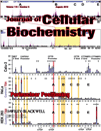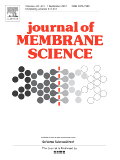
BIOLOGICHESKIE MEMBRANY
Scope & Guideline
Exploring the Frontiers of Cell and Molecular Biology
Introduction
Aims and Scopes
- Biophysical and Biochemical Characterization of Membranes:
The journal publishes studies focusing on the physicochemical properties of biological membranes, including lipid composition, membrane fluidity, and interactions with proteins and other biomolecules. - Cellular Mechanisms and Signaling Pathways:
Research articles often explore cellular signaling mechanisms involving membrane receptors and the impact of various ligands on cellular responses and homeostasis. - Mitochondrial Function and Bioenergetics:
There is a consistent emphasis on mitochondrial membranes, investigating their role in energy production, calcium signaling, and implications in various diseases. - Impact of Environmental Stressors on Membranes:
The journal features studies that investigate how external factors, such as oxidative stress or heavy metals, affect membrane integrity and function, particularly in plant and animal cells. - Novel Techniques in Membrane Research:
Papers often introduce innovative methodologies for studying membranes, including advanced imaging techniques, biosensors, and computational models.
Trending and Emerging
- Neurobiology and Membrane Dynamics:
There is a notable increase in studies examining the role of membranes in neurobiology, particularly concerning neurotransmitter receptors and calcium signaling in neuronal health and disease. - Nanotechnology and Membrane Applications:
Research exploring the use of nanomaterials for drug delivery systems through lipid membranes is on the rise, indicating a growing interest in therapeutic applications and biomedical engineering. - Metabolic Regulation and Membrane Interaction:
Emerging studies are focusing on the interplay between metabolic pathways and membrane dynamics, particularly in the context of diseases like cancer and metabolic disorders. - Immunology and Membrane Signaling:
An increased number of publications are addressing how membrane receptors and signaling pathways influence immune responses, especially in the context of viral infections and autoimmune diseases. - Membrane Engineering and Synthetic Biology:
There is a burgeoning interest in synthetic biology approaches to engineer membranes for various applications, including biosensors and biofuel production.
Declining or Waning
- Plant Membrane Studies:
Although plant membrane research has been a significant focus, the frequency of articles centered on chloroplast membranes and plant-specific lipid studies has decreased, possibly due to a shift towards more universal cellular mechanisms. - In-depth Studies on Viral Membrane Interactions:
Research specifically addressing the interactions of viruses with host cell membranes has diminished, indicating a potential waning interest or a shift towards broader immunological responses. - Toxicology of Membranes in Disease Contexts:
Papers exploring the toxicological effects of environmental agents on membrane structures have become less common, suggesting a possible pivot towards more targeted biochemical pathways rather than broad toxicological assessments.
Similar Journals

JOURNAL OF CELLULAR BIOCHEMISTRY
Shaping the Future of Biochemical and Cellular ResearchJournal of Cellular Biochemistry is a premier academic journal dedicated to advancing the field of biochemistry and cellular biology. Published by Wiley, this influential journal has a significant impact factor that underscores its relevance and authority within the scientific community. With its ISSN 0730-2312 and E-ISSN 1097-4644, the journal has been on the frontier of research since its inception in 1982, and is expected to continue publishing cutting-edge studies through 2024. As evidenced by its ranking in the 2023 Scopus Quartiles, it holds a rank of Q2 in Biochemistry and Q3 in both Cell and Molecular Biology, placing it among the top tiers of scientific journals in these disciplines. The Journal of Cellular Biochemistry serves as a vital resource for researchers, professionals, and students alike, providing a platform for the dissemination of innovative ideas and findings that shape our understanding of cellular processes and biochemical pathways. Though it does not currently offer Open Access options, its robust peer-review process ensures that each publication meets the highest academic standards, thus solidifying its esteemed position in the landscape of biochemical research.

Bioelectricity
Advancing Biomedical Frontiers with Electric InnovationsBioelectricity, published by MARY ANN LIEBERT, INC, is an esteemed journal dedicated to the interdisciplinary field that bridges biomedical engineering and electrical engineering, promoting research and innovation in the use of electrical signals for biological applications. Since its inception in 2019, the journal has established a solid reputation within the academic community, evidenced by its categorization in the Q3 quartile for Biomedical Engineering, Electrical and Electronic Engineering, and Medicine, alongside a notable Q2 ranking in Transplantation for 2023. With an ISSN of 2576-3105, Bioelectricity serves as a pivotal platform for disseminating cutting-edge research and fostering advancements in technology and medicine, drawing contributions from scholars globally. Although the journal operates under a traditional access model, it remains a critical resource for researchers, professionals, and students keen on exploring the potential of bioelectric phenomena in medical treatments and devices. As the field continues to evolve, Bioelectricity plays a vital role in shaping discussions and insights that propel innovations in health and engineering.

BIOPHYSICAL JOURNAL
Transforming discoveries into groundbreaking applications.BIOPHYSICAL JOURNAL, published by CELL PRESS, is a leading interdisciplinary platform dedicated to advancing the field of biophysics. With an ISSN of 0006-3495 and an E-ISSN of 1542-0086, this esteemed journal has garnered a prestigious position within the academic community, reflected in its ranking as Q1 in Biophysics for the year 2023. Its Scopus rank of #44/152 in the category of Biochemistry, Genetics, and Molecular Biology showcases its significant influence, with a notable percentile of 71st. Since its inception in 1960, the journal has published cutting-edge research that explores the quantitative and qualitative aspects of biological phenomena, making it essential for researchers, professionals, and students in the field. While the journal operates under a subscription model, its rigorous peer-review process ensures the highest quality of published work, contributing to groundbreaking discoveries and innovations that shape the future of biophysics. For more information or to explore the latest research, please visit the journal’s platform.

INTERNATIONAL JOURNAL OF BIOCHEMISTRY & CELL BIOLOGY
Illuminating the Path of Biochemical ExplorationThe International Journal of Biochemistry & Cell Biology, published by Pergamon-Elsevier Science Ltd, stands as a pivotal resource in the fields of biochemistry and cell biology. With an ISSN of 1357-2725 and an E-ISSN of 1878-5875, this prestigious journal has been a key platform for disseminating cutting-edge research since its inception in 1995. The journal currently holds an impressive Q1 ranking in Biochemistry and a Q2 ranking in Cell Biology for the year 2023, reflecting its commitment to high-quality research and its influence within the scientific community. With a significant Scopus ranking of 94/438 in Biochemistry and 96/285 in Cell Biology, the journal plays a crucial role in advancing knowledge and fostering innovative approaches in these dynamic fields. Though it is not an open-access journal, the International Journal of Biochemistry & Cell Biology remains accessible to a wide audience, making it a vital resource for researchers, professionals, and students alike, who are eager to explore and contribute to the ongoing advancements in biochemistry and cell biology.

Cell Reports Methods
Empowering Researchers with Cutting-Edge TechniquesCell Reports Methods is a cutting-edge journal published by CELL PRESS, focusing on innovative methodologies in the vast fields of biochemistry, genetics, biotechnology, and radiological sciences. Launched in 2021, it has rapidly ascended to attain a Q1 ranking across multiple disciplines in the latest 2023 metrics, reflecting its influential contribution to the scientific community. With an emphasis on practical and rigorous experimental approaches, this journal serves as a vital resource for researchers looking to advance their methodologies and collaborate on significant findings in their respective specialties. Despite not being an open-access publication, Cell Reports Methods ensures broad accessibility through institutional subscriptions, allowing researchers from various backgrounds to engage with high-quality scholarly work. The journal presents a unique platform for sharing insights from interdisciplinary methods that foster innovation and discovery, ultimately shaping the future of scientific research.

JOURNAL OF MEMBRANE SCIENCE
Exploring Innovative Solutions in Filtration and SeparationJOURNAL OF MEMBRANE SCIENCE, published by Elsevier, is a premier academic journal dedicated to advancing the field of membrane technology and its applications in various scientific domains. With its ISSN 0376-7388 and E-ISSN 1873-3123, this journal is recognized for its significant contributions to the study of filtration, separation processes, and materials science. As of 2023, it boasts an outstanding impact factor, ranking in the Q1 quartile across several categories including Biochemistry, Filtration and Separation, and Physical and Theoretical Chemistry, making it a leading resource in these fields. Researchers benefit from its rigorous peer-review process and the inclusion of breakthrough research, critical reviews, and cutting-edge developments. With converged years spanning from 1976 to 2025, the JOURNAL OF MEMBRANE SCIENCE stands out as an essential platform for professionals, students, and academics eager to explore innovative solutions and findings in membrane science. Although it operates under a traditional access model, its wealth of knowledge and global reach ensure that it remains an indispensable asset for anyone engaged in this dynamic area of study.

Biochemistry Moscow Supplement Series A-Membrane and Cell Biology
Fostering Excellence in Cellular ResearchBiochemistry Moscow Supplement Series A-Membrane and Cell Biology, published by PLEIADES PUBLISHING INC in the United States, is a pivotal journal in the fields of biochemistry, biophysics, and cell biology. Established in 2008, this journal has become a significant platform for disseminating novel research findings and reviews, fostering advanced studies in membrane dynamics and cellular processes. Although currently ranked in the Q4 quartile across its categories, the journal provides researchers and professionals with open access to a wealth of knowledge, helping to bridge gaps in understanding complex biochemical mechanisms. The journal’s commitment to quality and relevance is evident as it continues to contribute to the academic community through its coverage of innovative and emerging topics in cell and membrane biology. Researchers, practitioners, and students alike will find this resource invaluable for keeping abreast of the latest developments in the ever-evolving landscape of biochemistry and cellular research.

FEBS LETTERS
Pioneering New Ideas in Biochemistry and GeneticsFEBS LETTERS, published by Wiley, is a prestigious journal that has firmly established its place in the fields of biochemistry, biophysics, genetics, molecular biology, cell biology, and structural biology. With an esteemed history dating back to 1968, this journal continues to be a vital resource for researchers and professionals involved in the biological sciences. It boasts impressive quartile rankings, including Q1 statuses in several categories such as Biochemistry and Genetics, reflecting its high impact factor and significant contribution to scientific discourse. FEBS LETTERS provides a platform for innovative findings and critical reviews, fostering the exchange of knowledge and ideas within the scientific community. Although it operates under a subscription model, the journal ensures broad dissemination of groundbreaking research through its rigorous peer-review process. The vibrant discussions encouraged by articles published in FEBS LETTERS aim to inspire current and future generations of scientists to push the boundaries of biological understanding, making it an indispensable resource for anyone dedicated to advancing their knowledge in these dynamic fields.

CHEMISTRY AND PHYSICS OF LIPIDS
Advancing lipid science for a healthier tomorrow.Chemistry and Physics of Lipids is a prestigious and influential journal dedicated to advancing the understanding of lipid chemistry and biophysics. Published by Elsevier Ireland Ltd, it serves as a vital resource for researchers and professionals in the fields of biochemistry, cell biology, and molecular biology. The journal has a strong standing within the academic community, as reflected in its 2023 Scopus rankings, where it places in the 82nd percentile for organic chemistry and maintains significant positions in various biochemistry subfields. Spanning from 1966 to 2024, it fosters a comprehensive discourse on lipid-related research and innovation. As a renowned publication in the Q2 and Q3 quartiles across several categories, it supports the dissemination of high-quality research aimed at elucidating lipid functions and their implications in health and disease. Researchers and students alike will find this journal invaluable for staying updated with the latest developments and trends in lipid research.

Annual Review of Biophysics
Illuminating the Pathways of Biophysical ResearchThe Annual Review of Biophysics, published by ANNUAL REVIEWS, stands as a premier journal in the field of biophysics, offering an unparalleled collection of comprehensive and insightful reviews that synthesize the latest advancements in biochemistry, bioengineering, cell biology, structural biology, and more. With an impressive Q1 ranking across multiple categories as of 2023, this journal is recognized for its significant contribution to the scientific community, highlighted by its robust Scopus ranking—placing it in the 99th percentile for biophysics and the 96th percentile for structural biology. Operating under an open access policy, the journal ensures a broad dissemination of crucial findings and theoretical advancements. As the field of biophysics continues to expand, the Annual Review of Biophysics remains essential for researchers, professionals, and students seeking to stay informed about pivotal developments that shape our understanding of biological systems at the molecular level. One may refer to the journal for current trends, innovative methodologies, and a wealth of knowledge that drives the field forward.